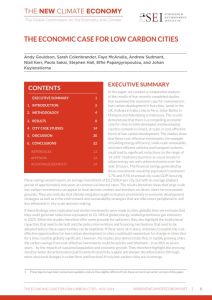Join getAbstract to access the summary!

Join getAbstract to access the summary!
Andy Gouldson, Sarah Colenbrander, Faye McAnulla, Andrew Sudmant, Niall Kerr, Paola Sakai, Stephen Hall, Effie Papargyropoulou and Johan Kuylenstierna
The Economic Case for Low Carbon Cities
SEI, 2014
What's inside?
Investing in low-carbon cities may quite literally pay off.
Recommendation
Lowering cities’ carbon emissions would be a crucial contribution to fighting climate change. But are low-carbon development models financially viable for cash-strapped cities? The Stockholm Environment Institute has prepared a report based on several studies of cities in both developing and developed countries. Yes, it argues, reducing emissions can be cost-neutral or even save cities money. getAbstract recommends this analysis to environmentalists, policy makers and ecofriendly investors.
Summary
About the Authors
The Stockholm Environment Institute is an independent international research organization that has been engaged in environment and development issues at local, national, regional and global policy levels for more than 25 years.

















Comment on this summary